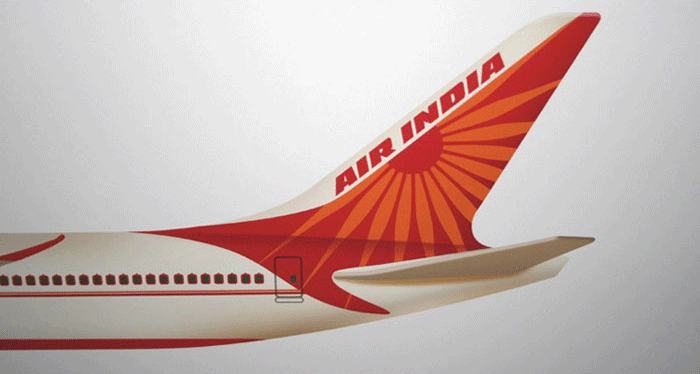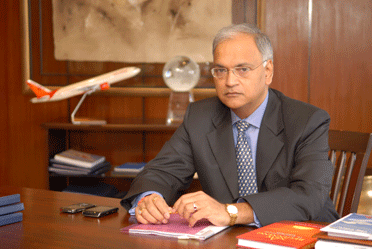 |
 |
|
| |
||
| Vol. 8 No. 77 WE COVER THE WORLD Wednesday July 22, 2009 |

 Dateline,
New Delhi—Air India’s financial problems continue to hog
headlines. The Chairman and Managing Director, Arvind Jadhav, has gone on
record to say that he was looking at various options to save money.
Dateline,
New Delhi—Air India’s financial problems continue to hog
headlines. The Chairman and Managing Director, Arvind Jadhav, has gone on
record to say that he was looking at various options to save money.
In an impassioned letter, the CMD sent out to
Air Indians, he asked them to rise to the challenge and make Air India fly
again. He reminded the employees that they had not felt the impact of problems
confronting the aviation industry – thus far -- because they had been
receiving their wages/salary every month even when people in the industry
in the country and abroad had lost jobs or seen their emoluments take a dip.
“The time has come for us to face the
moment of truth in Air India…This is an hour of crisis for all of us.
It is a fight for survival. The survival of our own airline. I am looking
for every single employee of our airline to rise to the challenge and demonstrate
that we not only have more experience in running an airline as compared to
others but also have the ability to overcome the crisis and emerge with flying
colors. The experience and commitment to the company will be of no gain, if
we cannot demonstrate this. We have to show our critics that all of us can
make Air India fly high again!” wrote the CMD. One can only hope that
the CMD succeeds in turning Air India around.
These problems, however, have not deterred the
cargo division to go ahead with its ambitious plans. The blueprint for cargo
development publicized around a year ago by Anita Khurana, Director Commercial
& Special Business Unit Head Cargo, National Aviation Company of India
Ltd (NACIL – the entity formed after Indian’s merger with Air
India), that had been put on the backburner after the fuel price hike, have
received a shot in the arm.
ACNFT had reported Khurana’s
announcement at that time that the losses incurred by Air India from diminishing
passenger traffic would be offset by cargo. The card that was up her sleeve
was the launch of the carrier’s domestic cargo service with a hub at
Nagpur. But the Nagpur hub plan had to be put on ice and Air India had to
curtail its cargo operations: the A310 freighter service from Bengaluru to
Paris had to be withdrawn “because that was not making enough money,”
as Khurana put it.
Today, the Cargo head is back to her exuberant
self. Her plans to take Air India cargo into the next decade are under implementation,
and if everything goes according to schedule, could we witness a renaissance
of sorts?
The prime mover in the erstwhile Indian’s
(Airlines) cargo automation, Khurana had hoped that the Indian-Air India merger
would not only boost international cargo operations but also that the automation
bit would put AI at par with the best in the world.
Talking to ACNFT, she said: “In
today’s fiercely competitive cargo industry, there is constant and increasing
pressure on airlines to provide high quality service, coupled with best tracking
information that should be available at the click of a mouse. In an effort
to provide the best service to the customers, airlines have started using
technological solutions for cargo, which gives them utmost control of the
sales and operations.”
Khurana knows what she wants for the national
carrier: “I wanted the latest state-of-the-art technology that would
be as friendly to the agent as it is to the customer.” Prior to the
merger, Indian (Airlines) was using a new generation integrated cargo solution
for its cargo operations, CSP, which is web-enabled and uses open technology.
On the other hand, Air India was using – and continues to use –
the rather outdated USAS cargo, a mainframe-based solution for cargo. Now,
Anita Khurana wants to synergize the operations of the two carriers and provide
identical services to the customers.
“What I am trying to do is bring both
the carriers to a common platform, which is the reservation platform. Air
India’s USAS system is very old and an outdated one, while the CSP from
Kale Consultants for Indian is user-friendly and up-to-date.” Work,
she pointed out, was on in Air India. “It will take another six months
for phase-wise implementation, and by April 1, 2010 both Air India and IC
(Indian Airlines) will be on the CSP system. We could begin from January 1
next year…by then we should have a number of stations done,” she
said.
A year from today, cargo agents using Air India
will not have to make harrowing trips to the airports to book their shipments.
Instead, all they have to do is enter the details on their computer from their
place of work and get everything done on the Net.
The system, once it comes into force, will enable
the cargo agents to have details of their shippers and consignees pre-recorded
in the system. “Our system will allow track and trace using the house
airway bill number. This is one facility that others do not have,” emphasized
Khurana, “and it is going to be a major achievement for us.”
Other than the automation, the Cargo chief has
moved on to create new sources of revenue for the flailing carrier. And, in
this depressed market, she has got results. “Inspite of the recession,
AI cargo has seen an increase. Yields and revenues have increased.”
A large percentage of the revenues have come from mangoes and perishables.
“For the first time, we have started promoting mangoes on our non-stop
flights from Mumbai to New York.”
For the moment, however, AI’s cargo head
is content with the progress she has made. “We have done very well in
the current season: the carriage figure for mango for the current season–both
domestic and international—by AI is 2,500 tons.”
Next year, she plans to venture to uncharted
territory – at least as far as Air India and perishables are concerned.
“I might even go to Tokyo,” she said. “If we have to promote
the carriage of perishables it would be at a low rate. We do not have a freighter
operating to New York, but now that our Frankfurt hub has come up, we could
use the line flights to promote exports. The freighters could then focus on
the express markets,” she said.
The downturn has not affected the cargo division.
“Our revenues have been pretty good. The February figures showed practically
an 8 percent increase from last year. As for mail, we have done very well
over last year.” Air India, incidentally, had not been carrying mail
at all but with Britain’s Royal Mail is using the national carrier and
Khurana said, “we are happy with the progress we have made in mail carriage.”
Tirthankar Ghosh
An
Air Cargo News/FlyingTypers Original Our
exclusive series “Women
In Air Cargo” asks our readers to send some words and a picture
about somebody that you know who is female and has made a difference
in air cargo.
|
|
July 21: Philippine Airlines lost $301 million in year ended March 31, blames fuel, says new B777s coming this year will help realize profits.
July 21: Boeing
finishes connecting first 747-8 F joining forward and aft fuselage with
wing & center. At 250Ft the 8 is 18 feet bigger than 400F.
|